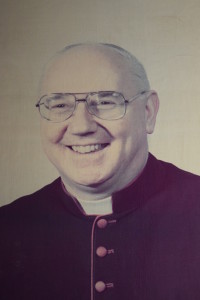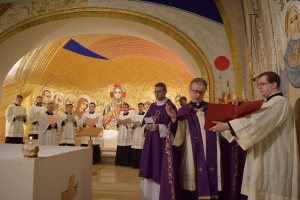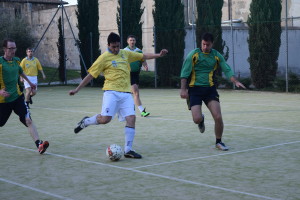Admission to Candidacy 2016
Posted on 17. Feb, 2016 by John Coughlan in Carousel
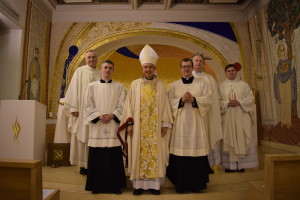
Left to right: Mons. Ciarán O’Carroll (Rector), Mr Malachy Gallagher (new Candidate), Archbishop Jorge Carlos Patrón Wong (Secretary for Seminaries, Congregation for the Clergy), Mr Bill O’Shaughnessy (new Candidate), Fr George Hayes (Vice Rector), Fr Hugh Clifford (Director of Formation).
Malachy Gallagher (Diocese of Derry) and Bill O’Shaughnessy (Archdiocese of Dublin), seminarians of the Pontifical Irish College, Rome, were admitted to Candidacy for Ordination to Diaconate and Priesthood by Archbishop Jorge Carlos Patrón Wong, Secretary for Seminaries of the Congregation for the Clergy on 17th February 2016 at Mass in the College Chapel. The two Candidates will be ordained to the Diaconate on Easter Tuesday, 29th March 2016.
The following is the homily preached by Archbishop Patrón Wong:
I would like to begin by thanking Monsignor Ciarán O’Carroll, the Rector, along with his colleagues on the staff of the College, Fr George (Hayes), Fr Hugh (Clifford) and Fr Tom (Norris), for the kind invitation to preside at this Holy Mass and the rite of admission to candidacy of Malachy and Bill. I am pleased to have this opportunity to return to the Pontifical Irish College and to mark this moment in the life of the seminary community with you.
Reading the Gospel, we might have expected that the Church would have proposed, in the first reading, the account of Jonah being expelled from the belly of the whale. This is the sign of the resurrection of which Christ speaks. Instead, we meet Jonah just as he finds himself on dry land once more, when the word of the Lord is addressed to him for the second time, asking him to call the people of Nin’eveh to repentance. And he set out, we are told, “in obedience to the word of the Lord”.
Christ made clear to his listeners that the sign of Jonah was the sign of their times, although they would only understand this afterwards. In fact, he remains always the living sign of the kairos in which we continue to live. “This is the favourable time, this is the day of salvation”, as we heard St. Paul remind us on Ash Wednesday (2Cor 6:2). The Risen Christ is the living sign of all times and seasons.
Since the resurrection is not an idea, nor even merely an event, but the living reality of a person whom we encounter, Christ addresses himself to each one of us in each generation; and he addresses each generation through us. His death and resurrection questions each new generation; and this he does through us, his ambassadors. Our message, like that of Jonah, belongs to Christ: “be reconciled to God” (2Cor 5:20).
We can notice a similarity between Jonah and the apostles: they fled from their calling. They fled from the fear of confronting the people of their own time with the word. Overwhelmed by their own insignificance and smallness, they were filled with fear. It was the encounter with the living God that took this away.
God, of course, understands our smallness, and chooses us precisely for that reason. The changing of hearts is not our doing, but the work of God. He sends each of his messengers at just the time they are needed, where they are needed, to whom they are needed. Today, for your generation, for your times, in your land, you are those men. He has sought you out, pursued you, given you signs of his concern for you, reassured you, and brought you to this day.
Each of you has been attentive to the word of the Lord for many years, in the changing circumstances of your lives. You have discerned the signs of the times, the signs of salvation time, in your own lives and generation. You have encountered the sign of Jonah and have come to know the crucified and risen Christ. You are now called to stop and consider well what the journey has brought you so far, before you move on.
In this, Jonah has another lesson for us. He too had to experience death and resurrection, as it were, before the word came to him a second time. Likewise the apostles: they had to experience Christ in his death and resurrection before he “opened their minds to understand the scriptures” (Lk 24: 45). This encounter with the person of Christ in his life, death and resurrection, an encounter that begins mystically by our baptism, must be made real, it must be given flesh. Like the apostles, when we have encountered the crucified and risen Christ we can experience both joy and doubt. But the man who has known Christ will be captivated by his presence enough to touch his wounds, which are all around us today. Pope Francis exhorts us continually, as you know, to touch the flesh of Christ, to encounter him in his suffering children. Our encounter with the crucified and risen Christ certainly involves the mystical encounter of the Spirit in prayer and sacramental life; but it is always an encounter with Christ incarnate, crucified and risen: we meet Christ in the flesh: – in the Eucharist, in his body the Church, and in the flesh of all humanity made in his image and likeness and which he has taken to himself.
You are asked if you can be, in the words of today’s rite, “men of discernment”, who recognise and can understand God’s signs, which daily reveal His will for your own generation. How much we need to bring our brothers and sisters to meet and know Christ in a concrete and real way. Hearts are waiting for relief. Lives that are broken by so much confusion are awaiting healing and light. A generation confident of its own lights is casting many into the shadows: it is a culture of waste, as Pope Francis repeats so often, discarding those who do not measure up, those who do not conform to consumption, those we cannot consume.
We can wonder at what difference our word might make, as Jonah did. But it is God’s word that saves; we must be merely its obedient servants. His word is living and true. It will not return to him empty without achieving what it was sent to do (cf. Is 55: 11). Christ is irresistible to true hearts in every generation. As Pope Saint John Paul put it famously: each generation is a new continent to be won for Christ. Or to recall the motto of Blessed John Henry Newman: heart speaks unto heart.
So, Malachy and Bill, you must not be afraid. The ground you will be sent to till is not barren; it is full of potential, it is, even now, awaiting the seed of the word that will be sown by your lives and ministry in the near future. Today, the Church confirms you in your discernment, encourages you to go on, and it begins to prepare you for that day when you will be conformed to Christ as his messengers who go forth in obedience to the his word.
+ Jorge Carlos Patrón Wong
Archbishop – Bishop emeritus of Papantla
Secretary for Seminaries
Ministry of Acolyte 2016
Posted on 30. Jan, 2016 by John Coughlan in Carousel
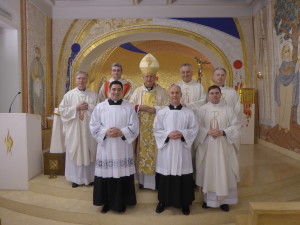
Photographs shows (left to right): Fr Thomas Norris (Spiritual Director), Rev. Stephen Duffy (Deacon for the Mass), Mr Robert Smyth (new Acolyte), Archbishop Claudio Maria Celli (President, Pontifical Council for Social Communications), Mr James Daly (new Acolyte), Mons. Ciarán O’Carroll (Rector), Fr Hugh Clifford (Director of Formation), Fr George Hayes (Vice Rector).
Two seminarians of the Pontifical Irish College,Rome, Robert Smyth and James Daly, both in formation for the Archdiocese of Dublin, were conferred with the Ministry of Acolyte by Archbishop Claudio Maria Celli, President of the Pontifical Council for Social Communications, on 13th January 2016 in the College Chapel. The role of an Acolyte is set out in Pope Paul VI’s Motu proprio, ‘Ministeria quaedam’ of 1972:
‘The acolyte is appointed in order to aid the deacon and to minister to the priest. It is his duty therefore to attend to the service of the altar and to assist the deacon and the priest in liturgical celebrations, especially in the celebration of Mass; he is also to distribute communion as a special minister when the ministers spoken of in the Codex Iuris Canonici can. 845 are not available or are prevented by ill health, age, or another pastoral ministry from performing this function, or when the number of communicants is so great that the celebration of Mass would be unduly prolonged. In the same extraordinary circumstances an acolyte may be entrusted with publicly exposing the Blessed Sacrament for adoration by the faithful and afterward replacing it, but not with blessing the people. He may also, to the extent needed, take care of instructing other faithful who on a temporary basis are appointed to assist the priest or deacon in liturgical celebrations by carrying the missal, cross, candles, etc., or by performing other such duties. He will perform these functions more worthily if he participates in the holy Eucharist with increasingly fervent devotion, receives nourishment from it, and deepens his knowledge about it.
As one set aside in a special way for the service of the altar, the acolyte should learn all matters concerning public divine worship and strive to grasp their inner spiritual meaning: in that way he will be able each day to offer himself entirely to God, be an example to all by his gravity and reverence in Church, and have a sincere love for the Mystical Body of Christ, the people of God, especially for the weak and the sick.’
Monsignor John J. Hanly, R.I.P.
Posted on 21. Jan, 2016 by John Coughlan in Carousel
The death has occurred of the former Rector of the Pontifical Irish College, Rome, Monsignor John J. Hanly.
A native of Oldcastle parish, he was educated at Rockwell, St Finian’s College and the Pontifical Irish College, Rome and was ordained in Rome in 1957. He completed his Doctorate in Ecclesiastical History at the Gregorian University in 1961, writing his Doctoral thesis on“The Conflict Between Blessed Oliver Plunkett and Archbishop Peter Talbot“. In 1979 he published, with translation and commentary, “The Letters of St Oliver Plunkett”. In 1960 he was appointed to the staff of St Finian’s College, Mullingar and in 1966 was appointed Director of Studies at the Pontifical Irish College, Rome. He was appointed Vice-Rector in 1968 and Rector in 1980. During his time in Rome, he was postulator of the Cause of Blessed Oliver Plunkett, the process being completed when the saint was canonised by Blessed Paul VI in 1975. In the 1970s he was appointed Postulator of the Causes of the Irish Martyrs (17 of whom were beatified in 1992 including Blessed Margaret Ball) and of Catherine McAuley and Nano Nagle. Monsignor Hanly was appointed Parish Priest of Laytown-Mornington in September 1987. He served as Vicar Forane from 1999 until 2006. He moved to Carnaross as Parish Priest in September 2008. He died on Wednesday 20 January 2016 after a short illness in Navan Hospital.
The community of the Irish College sympathises with the family of Monsignor John and with the Bishop and Priests of the Diocese of Meath, as well as the faithful of the Parish of Carnaross where Monsignor John had been Parish Priest until his death.
Fr John Silke, R.I.P.
Posted on 21. Jan, 2016 by John Coughlan in Carousel
The death occurred on 13th January 2016 of Dean John J. Silke, Raphoe Diocese, formerly archivist of the Pontifical Irish College, Rome. The community of the Irish College sympathises with his family and the Bishop, priests and faithful of the Diocese of Raphoe.
He was born on 7th May 1926 in Creeslough, Co Donegal and ordained Priest on 22nd June 1956 in Maynooth by Archbishop John Charles McQuaid. He received his primary education in Drimnaraw & Massinass National School, Creeslough. He went to St Eunan’s College, Letterkenny for his secondary education and to St Patrick’s College, Maynooth from where has was ordained to the Priesthood. He was Chaplain to Sacred Heart Convent, Leeson St., Dublin from 1952-1955 whe is studied at the History School in University College Dublin. From 1956-1957 he had a research Scholarship at Salamanca, Spain. From 1958-1959 he studies for the Higher Diploma in Education in Maynooth. From 1955-1966 he was on the teaching staff of St Eunan’s College, Letterkenny. From 1966-1973 he taught and studies at Harriman College, New York and Manhattan College. He was Archivist at the Pontifical Irish College, Rome from 1973-1980. From 1980 – 1981 he was a research fellow in Queens University, Belfast. In 1982 he was appointment Administrator of Glenswilly Parish and in 1983 he was appointed the first Parish Priest of Glenswilly where he reaimed until retiring as Parish Priest in 1992. He was appointed Diocesan Archivist by Bishop Mac Feeley, a position he held until the time of his death. Fr Silke was appointed a Canon of the Cathedral Chapter in July 2006 and then Dean of the Cathedral Chapter in August 2009.
Go dtuga Dia suaimhneas síoraí dó.
Doctoral Defence: Fr Daniel Ihunnia
Posted on 08. Jan, 2016 by John Coughlan in Carousel
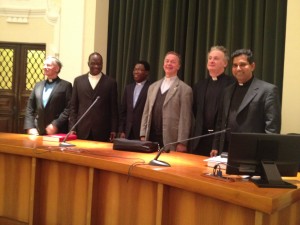
Fr Daniel Ihunnia pictured after his doctoral defence with his moderator and the members of the panel as well as Fr Tom Norris, Spiritual Director, and Fr George Hayes, Vice Rector, Pontifical Irish College.
Congratulations to Pontifical Irish College postgraduate student Fr Daniel Ihunnia of the Missionary Society of St Paul (Abuja, Nigeria) on the successful defence of his doctoral thesis, ‘The identity of the Christian Community in Africa: A study of the pastoral methods in the thoughts of P. A Kalilombe’ at the Pontifical Urbanianum University on 14th December 2015. The moderator for Fr Daniel’s thesis was Professor Paul B.W. Steffen, and the other members of the panel were Prof. Francis A. Oborji and Prof. I.J. Kodithuwakku Kankanamalage.
Carol Service 2015
Posted on 11. Dec, 2015 by John Coughlan in Carousel
A very large crowd attended this year’s Carol Service in the Irish College on Sunday, 13th December 2015 at 17.00. The occasion began with the Advent Service in the Chapel, followed by Christmas carols, and all shared in refreshments after. Fr George Hayes, Vice Rector was the presider and preacher this year.
For photographs of the occasion and video clips of the carols, click here.
St Columbanus – 1400th anniversary
Posted on 23. Nov, 2015 by John Coughlan in Carousel
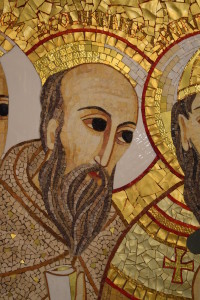
Saint Columbanus as depicted in the apse of the Chapel of All Saints of Ireland, by Fr Marko Rupnik SJ and the Centro Aletti.
The 23rd November 2015 was the 1400th anniversary of the death of Saint Columbanus and his feast day. Pope Benedict XVI described him as ‘the best known Irishman of the early Middle Ages’ in his General Audience talk of 11th June 2008. Here is the full text of the talk, telling the story of Saint Columbanus:
Dear Brothers and Sisters,
Today I would like to speak about the holy Abbot Columban, the best known Irishman of the early Middle Ages. Since he worked as a monk, missionary and writer in various countries of Western Europe with good reason he can be called a “European” Saint. With the Irish of his time, he had a sense of Europe’s cultural unity. The expression “totius Europae – of all Europe”, with reference to the Church’s presence on the Continent, is found for the first time in one of his letters, written around the year 600, addressed to Pope Gregory the Great (cf. Epistula I, 1).
Columban was born c. 543 in the Province of Leinster in southeast Ireland. He was educated at home by excellent tutors who introduced him to the study of liberal arts. He was then entrusted to the guidance of Abbot Sinell of the community of Cleenish in Northern Ireland, where he was able to deepen his study of Sacred Scripture. At the age of about 20 he entered the monastery of Bangor, in the northeast of the island, whose abbot, Comgall, was a monk well known for his virtue and ascetic rigour. In full agreement with his abbot, Columban zealously practiced the severe discipline of the monastery, leading a life of prayer, ascesis and study. While there, he was also ordained a priest. His life at Bangor and the Abbot’s example influenced the conception of monasticism that developed in Columban over time and that he subsequently spread in the course of his life.
When he was approximately 50 years old, following the characteristically Irish ascetic ideal of the “peregrinatio pro Christo”,namely, making oneself a pilgrim for the sake of Christ, Columban left his island with 12 companions to engage in missionary work on the European Continent. We should in fact bear in mind that the migration of people from the North and the East had caused whole areas, previously Christianized, to revert to paganism. Around the year 590, the small group of missionaries landed on the Breton coast. Welcomed kindly by the King of the Franks of Austrasia (present-day France), they asked only for a small piece of uncultivated land. They were given the ancient Roman fortress of Annegray, totally ruined and abandoned and covered by forest. Accustomed to a life of extreme hardship, in the span of a few months the monks managed to build the first hermitage on the ruins. Thus their re-evangelization began, in the first place, through the witness of their lives. With the new cultivation of the land, they also began a new cultivation of souls. The fame of those foreign religious who, living on prayer and in great austerity, built houses and worked the land spread rapidly, attracting pilgrims and penitents. In particular, many young men asked to be accepted by the monastic community in order to live, like them, this exemplary life which was renewing the cultivation of the land and of souls. It was not long before the foundation of a second monastery was required. It was built a few kilometres away on the ruins of an ancient spa, Luxeuil. This monastery was to become the centre of the traditional Irish monastic and missionary outreach on the European Continent. A third monastery was erected at Fontaine, an hour’s walk further north.
Columban lived at Luxeuil for almost 20 years. Here the Saint wrote for his followers the Regula monachorum – for a while more widespread in Europe than Benedict’s Rule – which portrayed the ideal image of the monk. It is the only ancient Irish monastic rule in our possession today. Columban integrated it with the Regula coenobialis, a sort of penal code for the offences committed by monks, with punishments that are somewhat surprising to our modern sensibility and can only be explained by the mentality and environment of that time. With another famous work entitled: De poenitentiarum misura taxanda, also written at Luxeuil, Columban introduced Confession and private and frequent penance on the Continent. It was known as “tariffed” penance because of the proportion established between the gravity of the sin and the type of penance imposed by the confessor. These innovations roused the suspicion of local Bishops, a suspicion that became hostile when Columban had the courage to rebuke them openly for the practices of some of them. The controversy over the date of Easter was an opportunity to demonstrate their opposition: Ireland, in fact, followed the Eastern rather than the Roman tradition. The Irish monk was convoked in 603 to account to a Synod at Chalon-sur-Saône for his practices regarding penance and Easter. Instead of presenting himself before the Synod, he sent a letter in which he minimized the issue, inviting the Synod Fathers not only to discuss the problem of the date of Easter, in his opinion a negligible problem, “but also all the necessary canonical norms that – something more serious – are disregarded by many” (cf. Epistula II, 1). At the same time he wrote to Pope Boniface IV – just as several years earlier he had turned to Pope Gregory the Great (cf. Epistula I) – asking him to defend the Irish tradition (cf. Epistula III).
Intransigent as he was in every moral matter, Columban then came into conflict with the royal house for having harshly reprimanded King Theuderic for his adulterous relations. This created a whole network of personal, religious and political intrigues and manoeuvres which, in 610, culminated in a Decree of expulsion banishing Columban and all the monks of Irish origin from Luxeuil and condemning them to definitive exile. They were escorted to the sea and, at the expense of the court, boarded a ship bound for Ireland. However, not far from shore the ship ran aground and the captain, who saw this as a sign from Heaven, abandoned the voyage and, for fear of being cursed by God, brought the monks back to dry land. Instead of returning to Luxeuil, they decided to begin a new work of evangelization. Thus, they embarked on a Rhine boat and travelled up the river. After a first stop in Tuggen near Lake Zurich they went to the region of Bregenz, near Lake Constance, to evangelize the Alemanni.
However, soon afterwards, because of political events unfavourable to his work, Columban decided to cross the Alps with the majority of his disciples. Only one monk whose name was Gallus stayed behind; it was from his hermitage that the famous Abbey of St Gall in Switzerland subsequently developed. Having arrived in Italy, Columban met with a warm welcome at the Lombard Royal Court but was immediately faced with considerable difficulties: the life of the Church was torn apart by the Arian heresy, still prevalent among the Lombards, and by a schism which had detached most of the Church in Northern Italy from communion with the Bishop of Rome. Columban entered authoritatively into this context, writing a satirical pamphlet against Arianism and a letter to Boniface IV to convince him to take some decisive steps with a view to re-establishing unity (cf. Epistula V). When, in 612 or 613, the King of the Lombards allocated to him a plot of land in Bobbio, in the Trebbia Valley, Columban founded a new monastery there which was later to become a cultural centre on a par with the famous monastery of Monte Cassino. Here he came to the end of his days: he died on 23 November 615 and to this day is commemorated on this date in the Roman rite.
St Columban’s message is concentrated in a firm appeal to conversion and detachment from earthly goods, with a view to the eternal inheritance. With his ascetic life and conduct free from compromises when he faced the corruption of the powerful, he is reminiscent of the severe figure of St John the Baptist. His austerity, however, was never an end in itself but merely the means with which to open himself freely to God’s love and to correspond with his whole being to the gifts received from him, thereby restoring in himself the image of God, while at the same time cultivating the earth and renewing human society. I quote from hisInstructiones: “If man makes a correct use of those faculties that God has conceded to his soul, he will be likened to God. Let us remember that we must restore to him all those gifts which he deposited in us when we were in our original condition. “He has taught us the way with his Commandments. The first of them tells us to love the Lord with all our heart, because he loved us first, from the beginning of time, even before we came into the light of this world” (cf. Instructiones XI). The Irish Saint truly incarnated these words in his own life. A man of great culture – he also wrote poetry in Latin and a grammar book – he proved rich in gifts of grace. He was a tireless builder of monasteries as well as an intransigent penitential preacher who spent every ounce of his energy on nurturing the Christian roots of Europe which was coming into existence. With his spiritual energy, with his faith, with his love for God and neighbour, he truly became one of the Fathers of Europe. He shows us even today the roots from which our Europe can be reborn.
Ministry of Reader 2015
Posted on 18. Nov, 2015 by John Coughlan in Carousel
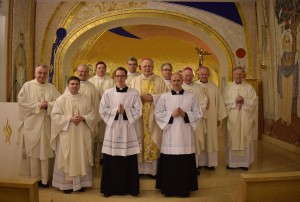
Left to right: Monsignor Ciarán O’Carroll (Rector), Fr Hugh Clifford (Director of Formation), Bishop Dónal McKeown (Derry), Bishop Francis Duffy (Ardagh and Clonmacnois), Mr Tony Shannon (new Reader), Rev. Stephen Duffy (Deacon), Bishop Leo O’Reilly (Kilmore, celebrant), Fr George Hayes (Vice Rector), Mr Seán Mulligan (new Reader), Bishop Philip Boyce (Raphoe), Bishop Brendan Kelly (Achonry), Fr Thomas Norris (Spiritual Director).
Two seminarians of the Pontifical Irish College, Rome, Mr Seán Mulligan (Diocese of Clogher) and Mr Tony Shannon (Diocese of Meath) were conferred with the Ministry of Reader by Bishop Leo O’Reilly of Kilmore at Mass in the College Chapel on 18th November 2015.
The Ministry of Reader is a Church ministry in itself, but it is also one of the steps along the way in formation for the Priesthood.
Here is the homily preached by Bishop O’Reilly at the Mass:
Last Sunday’s readings, from the book of Daniel and the Gospel of St Mark, were full of apocalyptic foreboding. We heard of great distress, cosmic chaos and things falling apart. In the midst of all this upheaval and uncertainty Jesus gives one ringing assurance to disciples: “heaven and earth will pass away but my words will not pass away.”
The word of Jesus will stand. The word of God is the one firm anchor in the stormy sea foretold by Jesus for his followers. These words must have reassured Peter in all the troubles he experienced as he preached the word – the hostility, the opposition and imprisonment. They must have strengthened Paul in his many travails – especially on his journey as prisoner to Rome. They stood to him when he and his companions were literally shipwrecked on the island of Malta and during his imprisonment in Rome where we find him in today’s reading. The astonishing thing is that the word of God, the message of Jesus continues to be proclaimed even from behind bars – as St Luke says – with complete freedom and without hindrance.
Heaven and earth will pass away, but my words will not pass away.
Today you will be instituted as readers, lectors, ministers of Gods word. This is one of what used to be called ‘minor orders’. But it is no small thing. The word of God is a powerful reality. The letter to the Hebrews tells us that it is sharper than any two- edged sword. So St Paul is invariably depicted in art – as he is in the great statue outside St Peter’s in the Vatican – with a two-edged sword in his hand. In the other great statue at the front of the basilica, St Peter is identified by the keys. The keys are the symbol of authority and in particular of the authority of St Peter as the authoritative preacher of God’s word in the Church.
The word of God is powerful because Christ is present in his word. You will recall that the Constitution on the Liturgy teaches that Christ is present at the celebration of Mass, not just in Communion but in the community gathered in his name, and in his word.
The responsibility for proclaiming God’s word then is a sacred one. You are making Christ present to your hearers as you proclaim his word. So while this ministry is a step on the road to priesthood for you, in a real sense it goes to the heart of what our priesthood is about. The Second Vatican Council’s document on priests has this to say: “Since no one can be saved who has not first believed, priests .. have as their primary duty the proclamation of the Gospel of God to all. (Presbyterorum ordinis 4) The liturgy of the ceremony says the same thing: “you will bring the message of salvation to those who have not yet received it.”
The Gospel gives us the classic image of the Church – Peter and the apostles in a fragile boat on a stormy sea. They are afraid, their faith is weak. They ask themselves, is Christ really with us or is he only a figment of our imaginations? That’s often how we experience the Church today. Things could seem to be falling apart. The ship is threatened with sinking. Commentators write about the Church as a thing of the past. Recently, a well-known commentator described it as a 1500 year old institution wiped out by the abuse crisis. We are being written out of the script. That is the world where you will proclaim God’s word.
Today’s Gospel is one to meditate on again and again. The words of Jesus: courage, it is I, do not be afraid, these are our defence. The word of Jesus will not fail. His word assures us the Church will not fail. Christ is with us – not as a shadowy, ghostly reality, but as a real presence in word and sacrament. Never forget that it is Christ’s word you proclaim; that heaven and earth may pass away, but Christ’s word will not pass away. You cannot share that word with others until you have accepted it yourself, till you have prayed and pondered it, tasted it and digested it.
I’ll leave you with the words of the ceremony itself: “In proclaiming God’s word to others, accept it yourselves in obedience to the Holy Spirit. Meditate on it constantly so that each day you will have a deeper love for the scriptures, and in all you say and do, show forth to the world Our Saviour Jesus Christ.”
Fr Ragheed Ganni Soccer Tournament 2015
Posted on 07. Nov, 2015 by John Coughlan in Carousel
The Fr Ragheed Ganni Memorial Soccer Tournament took place at the Irish College, Rome on Saturday, 7th November 2015. The annual tournament is dedicated to Fr Ragheed, an Irish College alumnus who was martyred for his faith in Iraq in 2007. Ragheed came to the Irish College in 1996 as a seminarian and was ordained priest in 2001. He stayed on in this college as a postgraduate priest until 2003 when he returned to Iraq. During his years in the Irish College, he played on the College soccer team, and so this tournament, the Fr Ragheed Ganni Cup was established in his memory.
Six teams took part, representing the Irish College, English College, Marist College, North American College, Beda College, and Scots College. An important feature of the Fr Ragheed Ganni Memorial Soccer Tournament is that it concludes with all the participants celebrating Vespers in the College Chapel. Fr Ragheed Ganni celebrated his first Mass as a Priest in this Chapel, and he is now depicted in the apse mosaic, carrying the martyrs’ palm branch.
Congratulations to the Venerable English College team, victorious in this year’s tournament.
To view photographs of the occasion, click here.
Ordinations to the Priesthood 2015
Posted on 06. Nov, 2015 by John Coughlan in Carousel
Two seminarians of the Pontifical Irish College, Rome were ordained to the Priesthood during Summer 2015.
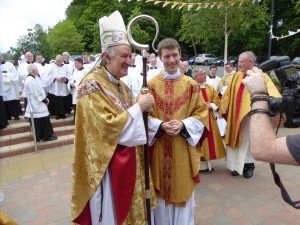
Fr Conor McCarthy with Bishop Anthony Farquhar, Auxiliary Bishop of Down and Connor after his ordination to the Priesthood.
Fr Conor McCarthy was ordained a Priest for the Diocese of Down and Connor by Bishop Anthony Farquhar, Auxiliary Bishop of Down and Connor, on 28th June 2015 in St Anne’s Church, Finaghy Belfast.
For photographs of the occasion, click here.

Fr Aidan McCann pictured after his ordination to Priesthood with the ordaining Bishop, Archbishop Eamon Martin and Irish College formation staff members Fr Hugh Clifford and Fr Tom Norris.
Fr Aidan McCann was ordained a Priest for the Archdiocese of Armagh by Archbishop Eamon Martin, Archbishop of Armagh and Primate of All Ireland, on 5th July 2015 in St Patrick’s Cathedral, Armagh.
For photographs of the occasion, click here.

